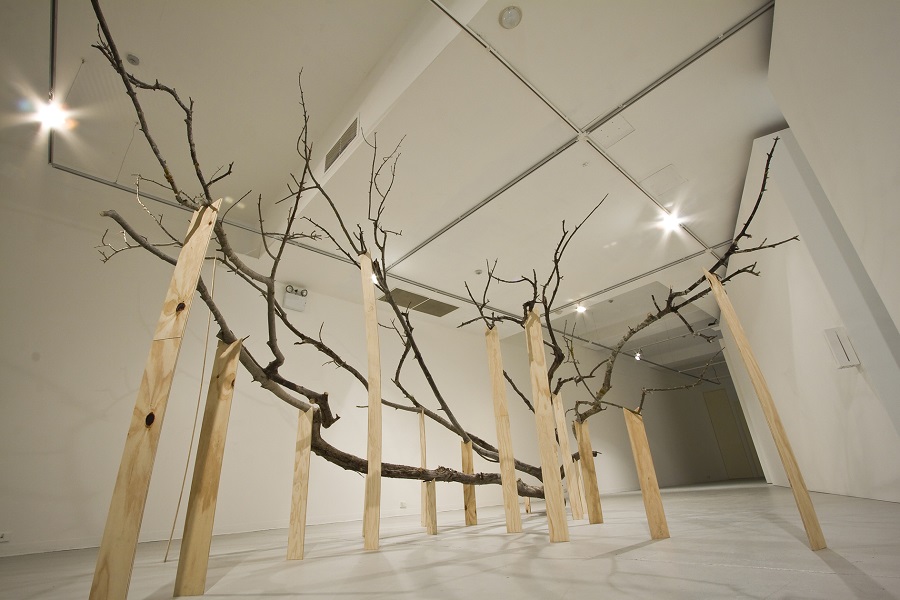There is a healthy democracy about her work and in her search for equalities between objects and the spaces they inhabit and delineate.
Image: Bridget CURRIE, Regulators, 2009, olive wood and plywood, spatial scent installation, photograph by Sam Roberts, © the artist
Bridget Currie
Born 1979, Kangaroo Island, South Australia
Bridget Currie is very much an artist of her time. Like many of her contemporaries she works across disciplines and from project to project in ways that fit well with Rosalind Krauss's theory of the post–medium condition. There is a healthy democracy about her work and in her search for equalities between objects and the spaces they inhabit and delineate. Some of these objects are produced through cooking, gardening, and sewing techniques, while others rely on what she calls 'traditional sculptural methods of installation, carving, casting, and assemblage. Gleaning materials from the local environment and using natural forms like tree branches to make sculptures that express an internal logic.'
Time spent in Japan has brought an exquisite balance to her work through observing the way dead trees are often used there to support the branches of living trees. There is a sense of one generation – of trees, or artists – supporting the next. Henry Moore, Eva Hesse and Lygia Clark pass on the baton of creativity to Carol Bove, Simon Starling, and Tobias Rehberger. And like all good artists the synthesis she makes is entirely her own. In one of her most recent projects (SASA Gallery, Adelaide, 11 August – 3 September, 2010) she collaborated with her sister, dance artist Alison Currie. She told me that 'The work stems from what Alison and I see as the shared conceptual history of Modernist dance and sculpture. Weight, load bearing, and spatiality are all emphasized. In the work we play with these ideas and also visual tropes of Modernism (particularly Minimalism) through the use of stark white geometric foam shapes and wheat coloured floor cloths.' Tellingly, she adds, 'There is a homage as well as a subversion there.'
Currie is an exceptional artist who would be just as at home with the Arte Povera group as she would with her contemporaries in Europe and Asia. Another recent work Regulators (2009) was inspired by her field work in Japan and saw her working in the gallery for a week preparing a large tree sculpture. She is aware that physics and engineering have for a long time investigated the forces of balance, weight, and pressure. Her research now puts these under the artist's gaze. Regulators was partly inspired by the crutch-like devices used in Japan to protect trees against snow fall, and in a punning way they become 'props'. Over the four years leading up to Regulators being installed at the Experimental Art Foundation, Currie had wanted to find a way of manufacturing scent to become part of the gallery experience. 'A chance meeting at a party allowed this to happen. What I wanted was a scent that evoked rotting compost but also had a top note of honey and nectar. Depending on where it was placed in the gallery, and on the movement of people through the space, the scent would vary from the foyer to the back of the building, sometimes coming in gusts, sometimes being more subtle.'
Text by Dr Peter Hill, artist and writer and Adjunct Professor of Fine Art at RMIT University, Melbourne.
2011 Anne & Gordon Samstag International Visual Art Scholarship
2011 Project Student, Royal Institute of Art, Sweden
2006 Masters of Visual Arts, University of South Australia, Adelaide
2001 Bachelor of Visual Arts (Honours), University of South Australia, Adelaide
Artist's website: www.bridgetcurrie.com

